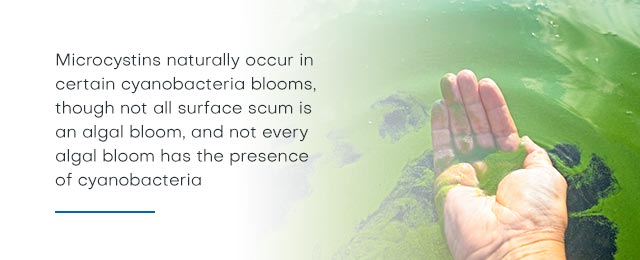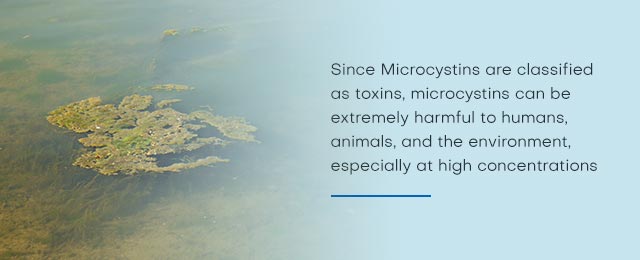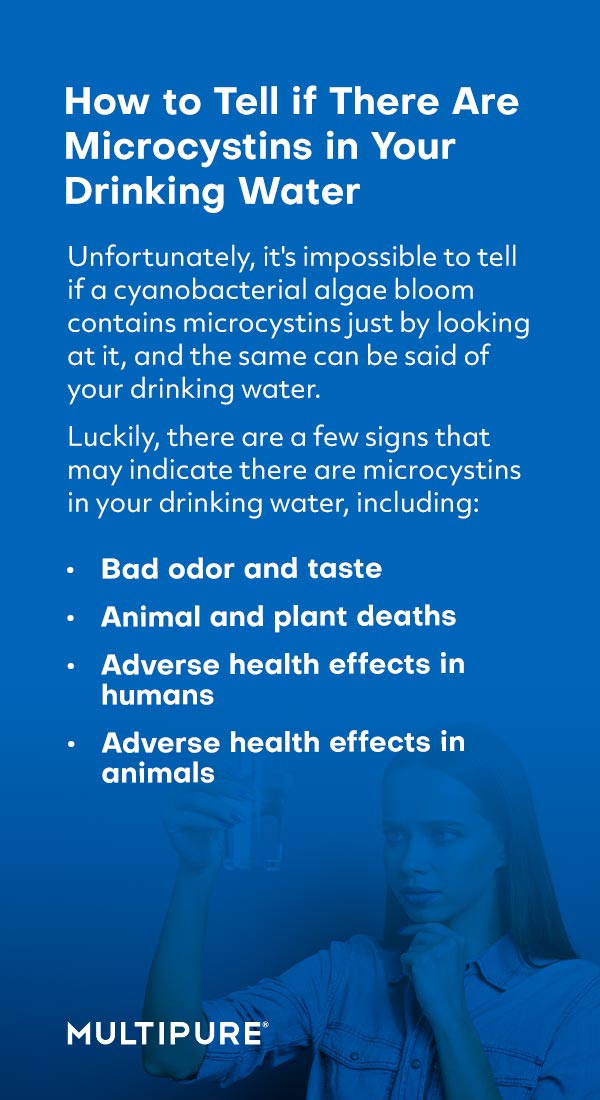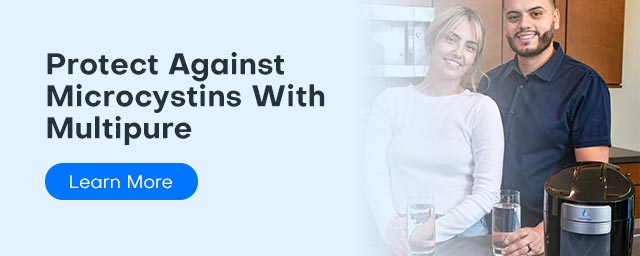Can Microcystins Be in Your Drinking Water?
Posted by Kenton Jones on Sep 29th 2022
Many modern homes have access to public water treated for various bacteria and contaminants to ensure it's safe for consumption. However, public water treatment centers generally only treat water for certain contaminants, and well water isn't automatically treated altogether. When cyanobacteria are present in drinking water, it can lead to the growth of harmful toxins like microcystins.
Find out what microcystins and cyanobacteria are, whether they could be in your water, and what can be done to treat toxins in your drinking water from home.
What Are Microcystins?
Microcystins are one of the most common toxins released from cyanobacteria, also known as blue-green algae. Cyanobacteria are algae that release toxins when the cells rupture or die in freshwater ecosystems, such as ponds and lakes. Microcystins are among the most dangerous cyanotoxins, seriously affecting human health, primarily the liver. Microcystins can also irritate the eyes, skin, and throat.
Different types of microcystin toxins are named based on their amino structures. The most commonly studied is microcystin-LR, though other common types include YR, RR, and LA. There are only suggested limits on consuming water contaminated with microcystin-LR, not the other types.
One of the most common ways you can be exposed to microcystins is through drinking water sources. Despite the health risks associated with these toxins, the United States Environmental Protection Agency (USEPA) doesn't currently regulate microcystins in drinking water. Still, many individual states have guidelines to maintain safe microcystin levels for public water sources, and the World Health Organization (WHO) currently suggests that microcystin-LR be limited to one microgram per liter of drinking water.
What Causes Microcystins?
Excess cyanobacteria growing in lakes or ponds will collect in blooms, which look like a film or scum on the water's surface. Microcystins naturally occur in certain cyanobacteria blooms, though not all surface scum is an algal bloom, and not every algal bloom has the presence of cyanobacteria. As such, understanding cyanobacterial growth is important to comprehend what causes microcystins.
 Cyanobacterial Growth
Cyanobacterial Growth
Cyanobacteria occur in warm water that has high concentrations of nutrients. When the conditions are right, cyanobacteria will multiply rapidly and blooms will collect on surface water. Most cyanobacteria occur in late summer, and many bodies of water that experience cyanobacterial blooms become prone to them.
Several factors can contribute to cyanobacteria growth, including:
- Light intensity and duration: Cyanobacterial growth is favorable under intense sun for long periods. For example, a shoreline that experiences direct sun throughout the day creates a favorable spot for algae to grow.
- Excessive nutrients: Cyanobacteria thrives in bodies of water with high nutrient concentrations, especially phosphorus and nitrogen. Excessive amounts of these nutrients are common around chemical, agricultural, and wastewater runoffs. These runoffs encourage cyanobacterial growth and ultimately increase the chance of microcystin production.
- Water temperature: Cyanobacterial growth is possible in water temperatures between 41-86 degrees Fahrenheit. Ideal temperatures for cyanobacteria and microcystin production are between 68-77 degrees Fahrenheit. Cyanobacterial blooms are so common at the end of summer and the beginning of fall because that's when these bodies of water have reached these optimal temperatures.
- pH: Neutral pH levels are ideal for cyanobacterial growth. Most cyanobacteria grow in water with a pH range of six to nine, which is relatively neutral and leaning towards alkaline. Most normal stream water and fresh bodies of water have pH levels around six or seven, creating optimal growing conditions for cyanobacteria and microcystins.
- Increased wet days: An increased number of small precipitation events can promote cyanobacterial growth. Big storms tend to flush out algae blooms, though a higher number of small rain events and wet days can encourage algal growth.
- Calm waters: Slow-moving and stagnant bodies of water create optimal growing conditions for algal blooms. Reservoirs, ponds, lakes, or slow-moving rivers experience fewer major surface water disruptions, allowing cyanobacteria to grow uninterrupted.
Microcystin Release
Microcystin is produced throughout the life cycle of cyanobacteria, though in 95% of blooms, the microcystins and other toxins are contained in the cyanobacterial cells. In these cases, the microcystins are only released into the water when the cells die or rupture.
Before the cells release the toxins, they cause minimal harm unless the bacteria is ingested. Once the microcystin is released into the aquatic environment, it contaminates the water. Some microcystins may even bind to clay and organic matter in the water, becoming extremely difficult to remove and manage.
Cyanobacterial algal blooms commonly form along shorelines. When these blooms dry up as the seasons change, they can still hold microcystins for weeks and months. The harbored microcystins can dissolve into the water even after the bloom has been long dead.
Do Microcystins Harm Humans?
Because they're classified as toxins, microcystins can be extremely harmful to humans, animals, and the environment, especially at high concentrations. When microcystins are present in an aquatic environment, you'll likely see dead plants and vegetation and increased animal deaths. In humans, microcystins present a host of harmful side effects. Most notably, microcystins are potent liver toxins and research suggests they may also be carcinogens.

rinking water is the most common route of exposure for humans, as you can unknowingly consume contaminated water. When microcystins are ingested, they can cause the most harm to human health. It's also possible to be exposed to microcystins through direct contact and inhalation, especially during recreational activities. For example, walking, swimming, or kayaking next to or through algae blooms or contaminated water can result in symptoms.
It's also possible to get microcystin poisoning from eating shellfish or fish that came from contaminated water. For example, the toxins in a lake can easily absorb into a fish's meat or the fish itself may be poisoned from ingesting the cyanobacteria. If you're fishing with the intent to eat the fish you catch, be cautious of where you're fishing and whether the body of water is affected.
Symptoms of Drinking Microcystins
When you come in direct contact with cyanobacterial blooms during recreational activities, you'll likely experience acute symptoms like skin irritation and other allergy-type symptoms. However, the symptoms of drinking microcystins tend to be more intense. Drinking microcystins primarily affects the liver, though there are different ways symptoms can present themselves.
Acute symptoms may include:
- Headaches
- Fever
- Joint and muscle pain
- Stomach cramps
- Diarrhea
- Blisters
- Mouth ulcers
- Allergic reactions
Severe symptoms include:
- Liver failure
- Seizures
- Respiratory arrest
- In rare cases, death
Further, long-term exposure to low levels of microcystins may promote tumor development. If you receive renal dialysis treatment for kidney failure, you're likely at a higher risk of microcystin poisoning because of the high volume of water in the body during treatment.
Could There Be Microcystins in Your Drinking Water?
Ultimately, the risk of having microcystins in your drinking water depends on where your water is sourced and how it's treated. If your drinking water is sourced from a body of water that cyanobacteria have affected, it's possible and likely that there are microcystins in your drinking water.
Well water is highly vulnerable because the contaminated water can flow underground into the wells. Treated drinking water is less likely to have microcystins, but it's still possible, especially if the water isn't treated for it specifically. Microcystin testing may not be routine at most water treatment centers unless the area is prone to outbreaks.
How to Tell if There Are Microcystins in Your Drinking Water

Unfortunately, it's impossible to tell if a cyanobacterial algae bloom contains microcystins just by looking at it, and the same can be said of your drinking water. Luckily, there are a few signs that may indicate there are microcystins in your drinking water, including:
- Bad odor and taste: Some cyanobacteria produce chemical compounds that can give water a musty smell and taste. The unpleasant taste and odor often indicate the presence of microcystins. However, it's important to note that microcystins don't always affect water's smell and taste. Plus, there are other causes of bad smelling and tasting water — microcystins are just one possibility.
- Animal and plant deaths: Microcystins may be why animals and aquatic plants die in and around your water source. Birds, livestock, and dogs are commonly reported dead where microcystin is in the water. Additionally, cyanobacteria and microcystin may lead to high fish and plant deaths in freshwater systems. Algae consume much of an ecosystem's oxygen, leaving low oxygen levels for fish and plants to survive.
- Adverse health effects in humans: Fatigue, headaches, nausea, and other adverse health effects that seemingly don't have a cause may result from microcystins in your drinking water. This is a particularly high risk of shallow wells sourced from surface water with ideal algae conditions.
- Adverse health effects in animals: Be sure to watch for adverse health effects in animals like dogs and cats, especially if they swim in lakes or ponds. Drinking contaminated water may cause symptoms like vomiting, diarrhea, strained breathing, profuse salivation, fatigue, and seizures.
You may want to have your water tested if you suspect microcystins in your drinking water. Water testing is one of the best ways to know for sure what contaminants are in your water supply.
How to Avoid and Prevent Microcystins
Because microcystins can potentially be extremely detrimental to human health, avoiding contact with bodies of water that are affected by algal blooms is recommended. Since it's impossible to tell which algal blooms contain microcystins, it's best to avoid them altogether. Avoid swimming, boating, and fishing in lakes and ponds that experience blooms. Don't use microcystin-contaminated water for anything, even watering your garden.
It's especially important to not drink water that's sourced from affected bodies. If your water is supplied by an affected body of water, don't use it unless it's filtered or treated. Partner with local water professionals to have them test for microcystin levels in your drinking water. Water professionals can perform an enzyme-linked immunosorbent assay (ELISA) test, among others, to receive accurate results regarding your water's contaminant levels.
Once your water is tested, you can work with the water treatment center or treatment providers to eliminate microcystins.
How to Get Rid of Microcystins
If your water testing results indicate there are high levels of microcystins in your water, you should start treating it immediately. While water treatment plants have a few methods for treating microcystins, the best ways to remove these toxins from within your household include membranes and filtration.
Here are a few effective methods for removing microcystins from drinking water:
- Carbon filters and membranes: Membrane filtration and reverse osmosis are effective options for many households, so long the right material and pore size are used. Carbon filters are reliable, depending on the type of carbon and pore size. Solid carbon block filters are among the best ways to eliminate microcystins in household drinking water.
- Ozone treatment and ultraviolet (UV) radiation: Ozone treatment involves oxidizing water with ozone, and UV radiation involves dissolving microcystin with focused UV light. Though these microcystin treatment systems are highly effective for reducing cyanotoxins in drinking water, they can be expensive.
- Home water filtration and purification systems: Entire home water filtration and purification systems ensure the water in your household is clean and safe for use. The best home water systems use carbon filtration and are certified to reduce microcystins.
Using NSF-Certified Water Filters to Prevent Microcystins
For the most effective microcystin removal and prevention, you should use NSF-certified water filters like those from Multipure. NSF-certified filters are individually tested and must meet specific requirements outlined by NSF International. Regarding microcystins, the NSF tests filters with real toxins to ensure they can remove the microcystins to a level for safe consumption. With NSF certification, you can be fully confident in the microcystin treatment.
Multipure's carbon block water filters meet the NSF requirements for effective cyanotoxin treatment. Our Aqualuxe is NSF-certified and passed independent testing for microcystins and various other viruses and bacteria. This industry-leading filtration system features the necessary carbon block filter and an additional microbiological filter, allowing it to purify drinking water. The Aquaperform filter offers the same certified, high-performance carbon filter without the microbiological filter.
While our other two carbon block filters — Aquaversa and Aquamini — haven't been individually tested for microcystin treatment, they offer similar capabilities as the Aquaperform and can help reduce cyanotoxin concentrations in drinking water. All Multipure carbon filters are designed with Environmental Protection Agency (EPA) cyanotoxin treatment guidelines in mind and will reduce the presence of cyanotoxins like microcystins in drinking water.
Protect Against Microcystins With Multipure
Multipure offers a premier way of filtering water in your house, yard, or on the go. With our help, you can ensure your home has a safe, reliable source of drinking water. Microcystins, among many other contaminants, can harm your and your family's health, especially when consumed over long periods. When you use Multipure filters to treat your water, you'll get unparalleled water filter performance backed by lifetime warranties and a 90-day money-back guarantee.
With over 50 years in business, we have the knowledge and experience to provide exceptional products and service for you. Contact us to learn more about our carbon block filters for protection against microcystins.


